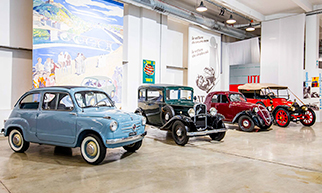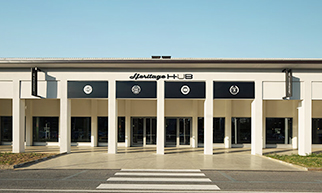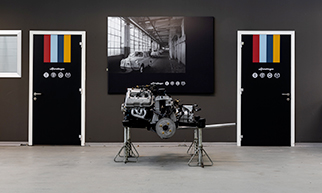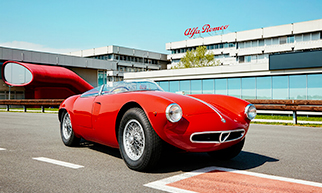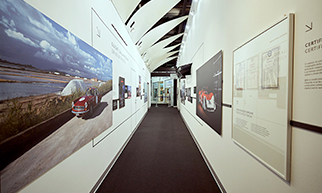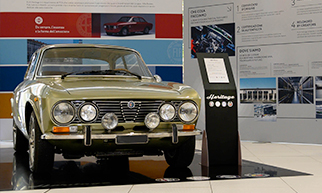The contest for the design of the official poster of the Concorso d’Eleganza Festival Car has come to a close and the winning image features the silhouette of the unmistakable Lancia Flaminia Loraymo (1960) Lancia Flaminia Loraymo (1960), the extraordinary prototype of the Flaminia Coupé created by the brilliant American designer Raymond Loewy.
This stunning poster will promote the fourth edition of the Festival Car Concorso d’Eleganza taking place on September 28th. Organized by Autoappassionati, the event will light up the streets and squares of Revigliasco Torinese, a charming hamlet located in the hillsides surrounding Turin, providing classic-car lovers with a unique experience in a historic setting.
As part of the Stellantis Heritage collection, and usually on show at the Heritage Hub in Turin, the Lancia Flaminia Lorayamo is a one-of-a-kind model and will make an appearance at the 2025 Festival Car Concorso d’Eleganza, which this year has become an official event in the international calendar of the FIVA (Fédération International des Véhicules Anciens)—the most important classic car federation in the world. With this event, Lancia strengthens its ties to Piedmont, the brand’s historic home and a place where tradition, innovation, and a passion for automobiles continue to join forces and flourish.
To enjoy an emotional journey through automobile history, the public can walk through the doors of the Heritage Hub, Stellantis’ exposition space located in the Mirafiori industrial area in Turin. Housed within the faithfully restored, historic Officina 81 plant in Via Plava, the Heritage Hub holds over 300 classic cars and takes visitors on an immersive journey through Italian automotive history. 64 classic cars, divided in 8 thematic areas, are showcased at the center of the exposition space, including the Flaminia Loraymo displayed in the “Concepts and Fuoriserie” area. In the right nave, it is possible to admire the impressive collection dedicated to Lancia, including 9 vehicles which inspired the brand’s future design, such as the Aurelia B24 Spider, the “presidential” Flaminia, and the Stratos. Plus, a special area has been dedicated to Lancia’s legendary rally vehicles. An unparalleled period in terms of technical and racing triumphs, “The Rally Era” section features the titans of on- and off-road racing history, such as the Fulvia HF, the Stratos, the 037, and the Delta Integrale.
The new Festival Car 2025 poster designed in collaboration with IED Torino
The poster of the Festival Car 2025 was produced in collaboration with IED Turin. Students working towards a bachelor’s degree in Transportation Design worked hard to produce a concept which included the poster, flags, and banners for the communication campaign of the fourth edition of the Festival Car 2025. A visit to the Heritage Hub in Turin provided all of the students participating in the contest with the unique opportunity to take a look up close at the star of 2025 edition, the Lancia Flaminia Loraymo. This experience provided vital inspiration and allowed the young designers to pick up on important details for their projects. Among the 40 submissions for the contest, the winning project came courtesy Mercedes Alazraki, who drew inspiration from the art and mood of the Sixties, which are perfectly embodied in the vehicle as well. In addition to Revigliasco Torinese and the Flaminia Loraymo, the star of this year’s event, the poster features Viola Erickson Loewy, the wife of Raymond Loewy, seated on its hood and casually flipping through a map of Piedmont to symbolize both the era’s chic and refined spirit and the joy and freedom of driving.
Lancia Loraymo, the splendid American prototype of the Flaminia Coupé
Made in just one single model in 1960 as a rebodied Flaminia Coupé, the Lancia Loraymo was created by the industrial designer Raymond Loewy, who was famous for designing the iconic glass Coca-Cola bottle and the Lucky Strike package. A French-born American, Loewy designed the vehicle for his personal use and had it made by Turin-based coachbuilder Rocco Motto, who was especially skilled in aluminum; meanwhile, the mechanics were tuned by Nardi, who boosted the 2.5 L V6 engine from 119 HP to around 150 HP. The designer was so happy with the result that he decided to present the car at the 1960 Paris Motor Show. Loraymo is an acronym of the designer's surname and name—LOEwy RAYMOnd— which was also the telegraphic address of his studio. Loewy used his Flaminia as his personal car for years, first in Europe and then in the United States. Several years after his death, the car was rediscovered by the president of the American Lancia Club, who decided to repatriate it by donating it to Lancia. Its most striking features include the tapering front end with gaping grill enclosed by a prominent chrome frame, which also serves as a bumper. The two outrigger fog lights are detached from the body by an aerodynamic fin and tucked under the headlights on the front fenders, which are slightly open-ended at the bottom to allow for better brake cooling. The sinuous shape incorporates highly sophisticated aerodynamic solutions, such as the fully closed chrome wheel rims and the aileron above the rear windscreen—a highly advanced solution for its time, which a few years later would be used on the Lancia Stratos HF. Lastly, the wraparound rear windscreen overhangs the boot, which is only accessible from the passenger compartment. The only protruding rear elements are the twin exhaust pipes and slim bumper, while the taillights are flush with the body.
Lancia’s return to the rally world
Lancia returns to rally racing with a project which unites its past to its future, its traditions to its vision of the future. The debut of the New Ypsilon Rally4 HF and the introduction of the Trofeo Lancia in the Italy Rally Championship 2025 mark the beginning of a new motorsport adventure which calls back to its legendary history, top-class drivers, and iconic models such as the Stratos, the 037, and the Delta HF Integrale. However, this journey goes far beyond mere nostalgia: Lancia is focused on the future with a desire to invest in young talents and build a bridge between its haloed past and the challenges of a constantly evolving motorsport world. The star of this comeback is the Ypsilon Rally4 HF, a vehicle designed for lower categories, but able to guarantee the performance expert drivers require as well. After all, the project has been appreciated by plenty of drivers and tuners from the get-go. The vehicle’s success has been underlined both by its sales—with it set to surpass 90 units sold in just four months—and a boom in registrations to the Trofeo Lancia, which has already hit its cap of 40 participants. Equipped with a 212-HP, three-cylinder 1.2 Turbo engine paired with a SADEV 5-speed gearbox with a next-generation mechanical limited-slip differential, the Ypsilon Rally4 HF features exceptional fine-tuning which was personally carried out by Miki Biasion, a true motorsports legend who, between the 80s and 90s, became inextricably linked to Lancia and went on to become the most successful Italian driver in history. Behind the wheel of the iconic Delta of the Martini Racing team, Biasion won the 1988 and 1989 World Championships, helping Lancia become the most successful brand ever with ten World Constructors’ Championships, three World Sports Prototype Championship, one 1000 Miglia, two Targa Florio, and one Carrera Panamericana. In conjunction with the debut of the Ypsilon Rally4 HF, the Trofeo Lancia will take place across five races within the 2025 Italian Rally Championship, kicking off with the Targa Florio and ending at the legendary Rallye Sanremo. With an impressive €360,000 prize fund, the Trofeo Lancia has established itself as one of the highest paying cups on the national stage and provides drivers with the chance to win a spot in the official Lancia Corse HF team led by Eugenio Franzetti in the next FIA ERC season (if the winner is an Under-35). In short, Lancia is not only making a return to rally to pay homage to its past, but is getting ready to open a new chapter with the audacious and innovative spirit which has always set it apart.
Lancia stars in “The Rally Era” section of the Heritage Hub
“The Rally Era” section at the Heritage Hub is a mélange of history and speed, a place where you can relive rally’s glory days between Sixties and Nineties—a period of success and evolution in this category. With respect to Formula 1, the premier class in motorsport, Rally championships received just as much, if not more, attention and support from fans throughout Europe back then. They not only got your heart racing, but also led to technological advancements. Races in those days, and rally ones in particular, turned out to be especially useful for experimenting with new composite materials which would later find their way to normal production vehicles, offering efficiency, lightness, safety, and driving pleasure. With major contributions from drivers like Sandro Munari and Miki Biasion, and their respective co-pilots Mario Mannucci and Tiziano Siviero, Lancia’s unstoppable domination during its rally era is indelibly linked to a number of models which became symbols of its immense technical knowhow and the value of the original vehicles’ designs, even from a strictly ergonomic and formal point of view. Visitors to “The Rally Era” can take a look up close at marvels such as the Lancia Fulvia HF, whose #14 legendary 1972 Monte Carlo Rally winning model is on display; the Lancia Stratos HF, winner of three World Constructors’ Championships, a futuristic and unstoppable vehicle which was used as a laboratory for countless technical and stylistic solutions; the Lancia Rally 037, the last two-wheel-drive vehicle to win the World Championship; and the Lancia Delta HF, which still holds the record for world titles, with six won between 1987 and 1992. There is even space for the Lancia Delta S4 Martini, the first Italian 4x4 used in racing, and the captivating Lancia ECV2, the 1988 prototype designed to revolutionize the rally world.
